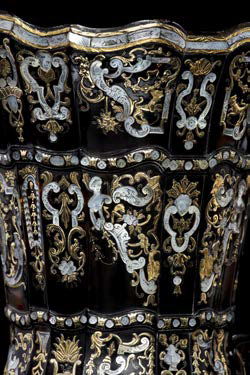Galerie J. Kugel presents the first exhibition devoted to the art of ‘piqué’ at the court of Naples
© Galerie J. Kugel
PARIS.- Galerie J. Kugel presents the first exhibition devoted to the art of ‘piqué’, which flourished in Naples during the first half of the 18th century. The technique combines lavish inventiveness, virtuoso skill and astonishing opulence.
These extraordinary objects bring together three precious materials: tortoiseshell, gold, and mother-of-pearl. According to Nicolas Kugel: “This fascinating combination is sublimated by light, which makes the gold shimmer, reveals the iridescence of the mother-of-pearl, and penetrates even the diaphanous darkness of the tortoiseshell.”
The exhibition includes over 50 objects, highlighting a table by Sarao - the ultimate masterpiece made using this technique – here lent, for the first time, by the Hermitage Museum in Saint Petersburg.
These pieces were created between 1720 and 1760 for connoisseurs and the court, and particularly for Charles of Bourbon, who became king of Naples in 1734, and made his court one of the most splendid and cosmopolitan in all Europe.
The artisans who created these masterpieces were known as “Tartarugari”. Giuseppe Sarao, the most famous among them, had a workshop adjoining the walls of the royal palace. Several of the pieces in the exhibition were made by him.
These talented artists were able not only to join and mould the tortoiseshell using boiling water and olive oil, but also inlaid gold and mother-of-pearl into the still-soft tortoiseshell. They created the most extravagant shapes, which they adorned with fashionable “piqué” decors such as singeries (scenes where monkeys engage in human activities), chinoiseries, and grotesques.
Alexis Kugel explains: “The exhibition will allow visitors to discover both the incredible inventiveness of the artists and the extraordinarily keen interest this art sparked among 19th century collectors, including several members of the Rothschild family. Many pieces boasting that prestigious provenance will be presented.”
The exhibition is accompanied by an illustrated catalogue, offering the first complete study of the subject. The French version will be published by Monelle Hayot and the English version by Rizzoli.
September 12- December 8 2018. Exhibition Monday to Saturday from 10:30 am to 7:00 pm, admission free
Galerie J. Kugel. 25, quai Anatole France, 75007 Paris - +33 1.42.60.86.23 - www.galeriekugel.com
Giuseppe Sarao, Elaborately shaped ewer with pelmet motifs. Tortoiseshell piqué with gold and mother-of-pearl. Signed above the handle: GS FN; Naples, circa 1735-1745. H. 21.8 cm; L. 21.6 cm; D. 21.7 cm. © Galerie J. Kugel
Provenance: -Baron Henri de Rothschild (1872-1947).
Attributed to Giuseppe Sarao, Lidded goblet surmounted by a monkey playing the flute. Tortoiseshell piqué with gold and mother-of-pearl, Naples, circa 1730-1740. H. 31 cm; D. 13.9 cm. © Galerie J. Kugel
Provenance:-Baron Mayer Carl von Rothschild, Frankfort (1820-1886)
- Baroness Theresa de Rothschild (1847-1931), his daughter (wife of James de Rothschild)
Giuseppe Sarao, Large coffer with chinoiserie decor standing on four turtle-shaped legs. Tortoiseshell piqué with gold and mother-of-pearl. Signed in gold along the edge “Sarao fecit Napoli”. The inside of the cover is adorned with the arms of Charles de Bourbon, king of Naples; Naples, circa 1735-1740. H. 28 cm; L. 42 cm; D. 33.5 cm. © Galerie J. Kugel
Provenance: -Sir Julian Goldsmid, Bart.
-His sale, Christie’s, Manson & Woods, London, 8-14 June 1896, lot 1105.
Giuseppe Sarao, The Hermitage Table, Naples, circa 1730-1740. © Galerie J. Kugel
The extraordinary table from the Hermitage Museum is the greatest masterpiece to have been created using the “piqué” technique. It is also the only table to have retained its original legs. The triangular shape of the legs is also present in the cabinet from the Royal British Collections. The extraordinarily inventive and elaborate tabletop is adorned with over a hundred chinoiserie figures, while countless animals, monkeys, insects, birds, and dragons also inhabit the space. The six main medallions depict Chinese couples in gold and mother-of-pearl, two of which are also found on the turtle casket, (page 4). The compartments are decorated with small Chinese figures made of cut out and engraved gold. In the centre, four gold vases symbolise the seasons; the figures between refer to the same theme. The centre is adorned with a small cartouche in which two Chinamen rock back and forth on a seesaw. The Chinese theme continues on the legs and stretcher. Underneath the medallion with the Chinese couple there is the monogramme SfN, which stands for Sarao fecit Napoli. In 1886 Baron Stieglitz purchased the table from the Frankfort antique dealer Goldschmidt, who was one of the main suppliers to Mayer Carl de Rothschild, also a great connoisseur of tortoiseshell piqué. It was no doubt the death of Mayer Carl that same year (1886) that allowed Stieglitz to acquire the table. It stood in the Stieglitz Museum of Applied Arts and was transferred to the Hermitage after 1924.
© Galerie J. Kugel

/https%3A%2F%2Fprofilepics.canalblog.com%2Fprofilepics%2F1%2F0%2F100183.jpg)
/https%3A%2F%2Fstorage.canalblog.com%2F03%2F02%2F119589%2F96711876_o.jpg)
/https%3A%2F%2Fstorage.canalblog.com%2F11%2F31%2F119589%2F94773502_o.jpg)
/https%3A%2F%2Fstorage.canalblog.com%2F20%2F83%2F119589%2F94772815_o.jpg)
/https%3A%2F%2Fstorage.canalblog.com%2F26%2F72%2F119589%2F75604929_o.jpg)
/https%3A%2F%2Fstorage.canalblog.com%2F59%2F60%2F119589%2F26458628_o.jpg)









/http%3A%2F%2Fstorage.canalblog.com%2F41%2F07%2F119589%2F120594976_o.jpg)
/http%3A%2F%2Fstorage.canalblog.com%2F06%2F44%2F119589%2F111451779_o.jpg)
/http%3A%2F%2Fstorage.canalblog.com%2F29%2F41%2F119589%2F110528840_o.jpg)
/http%3A%2F%2Fstorage.canalblog.com%2F36%2F01%2F119589%2F110352427_o.png)